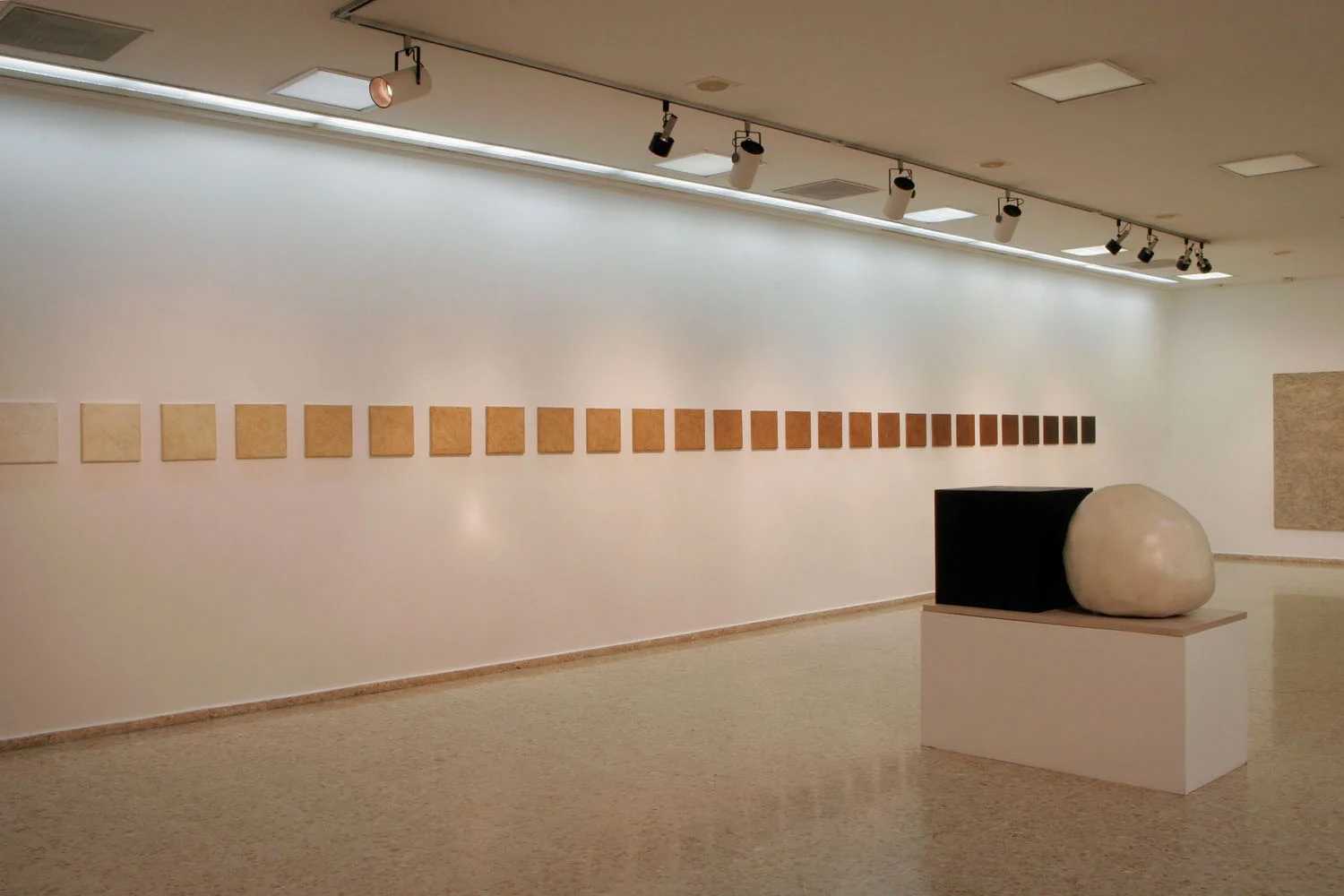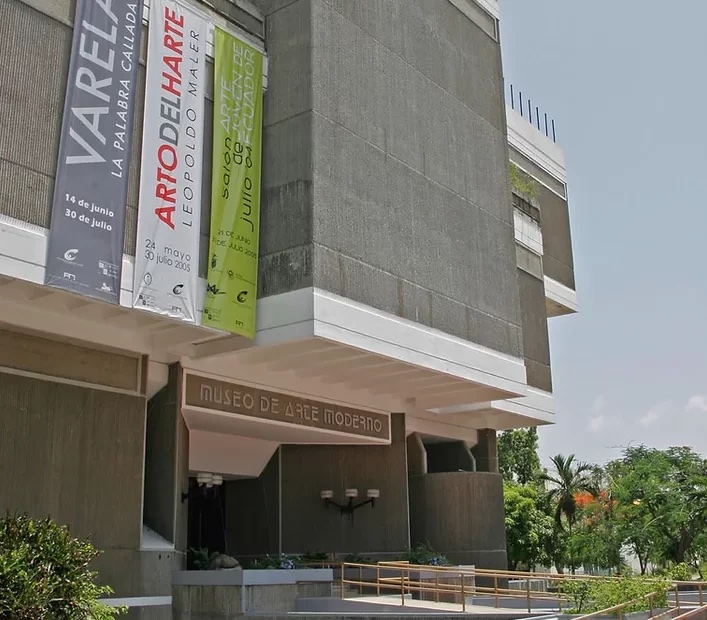The Museum of Modern Art is offering a landmark season with three very distinct and valuable exhibitions: the Salón de Julio (July Salon)—young Ecuadorian painting—a multimedia anthology by Leopoldo Maler, and drawings, sculptures, and paintings by Fernando Varela. Coincidentally, due to the origins of the exhibitors, South America—Ecuador, Argentina, and Uruguay—is the exclusive venue for the institution at the Plaza de la Cultura. A highly interesting and high-quality collection.
Eloquence of “The Silent Word”
When, after being struck by Leopoldo Maler's installations on the second floor of the Museum, the viewer is confronted with Fernando Varela's exhibition, occupying all the spaces at street level, the dramatic impression continues. The letters, thrown and embedded in the canvases, resemble the mingled names—or their initials—barely buried in earth bearing unknown victims. This could be a first interpretation of these mysterious and fascinating surfaces. But if we begin the visit with the works that make up "The Silent Word," the same association certainly won't emerge, and other reflections arise.
We want to make this observation, almost from the outset, to avoid the simple label of minimalism, which many would be tempted to apply to Fernando Varela's later palimpsests and stelae. An eminently metaphysical impression is produced when looking at his worlds, which, even in drawings and paintings, are never reduced to the two dimensions of canvas or paper. The apparent similarity of the works, in different formats and colors, deceives only the hasty and superficial viewer, or those who wish to place the work in a familiar style.
This is not an exhibition that one walks through, but rather unfolds. As always in the artist's visual proposals, mystical and/or magical signs arouse intense curiosity and become a source of meditation... if not obsessive. What mysteries lie behind these media, both visual compositions and graphic decompositions? If we choose to privilege the letter, the word, the (anti)text or "a-text," we surpass the immediacy of the gaze, which is naturally succeeded by the efforts of the mind. We believe that an "anti-philosophical" person, or one who simply seeks ease of appreciation, remains alien to the plural meaning of Varela's work and to its enriching readings, today as yesterday.
A complete and complex expression
Fernando Varela ignores concessions to craftsmanship, taste, and elegance. When we look closely at his works, we find these values of a purely artistic and aesthetic nature, an expression of beauty that elevates inner values and demonstrates mastery of the objective. We will reiterate that, in the continuation of a perfectionist technique, an implacable self-demand is embedded in a masterful commitment, existing since—incidentally—his solo exhibition at the Museum (then Gallery) of Modern Art in 1988.
The neatness of the execution is now a true hallmark—perhaps a metamessage—that inscribes, engraves, and scarifies the signs into the epidermis of each of the works, with greater or lesser depth. This carefully cultivated maturity elaborates, or rather, shapes, the material on several levels: the color and tone that underlie chromaticism, the nuances that design a shifting topography, the letters that constitute the fundamental aspect of this collection. These components orchestrate a higher reality or a supra-reality, depending on how we interpret them. In Fernando Varela's creation, there has always been, consciously, a symbiosis of sign and symbol, if not an obvious allegory—thus, in the past, the transmutation of the chalice.
José Bobadilla, in his beautiful essay for the pre-catalogue, made a personal analysis, all in finesse and wisdom, that merits several citations… For example, he states: “There are no concessions. The complacent ease of gestures or figurations that lead the idea toward an argument with intelligible contours does not exist (…) No. Varela does not give us answers. He gladly introduces us to the abysmal perspectives of his doubts and certainties.” The writer and poet continues, with his approach to Varela's silence…
"The Silent Word," the title of the exhibition, would be equivalent to a period of silence, a minute or an eternity. We can also decipher it as a random score, or, in a synesthetic transference, hear this renewed letterism, like an immense cacophony. Curiously, if we perceive any silence, it will be that of the viewer, who—while truly interested—delays their gaze and spontaneously withdraws, participating in the search and seeking the clues of the image.
We would say that Fernando Varela invites us to read... starting with his Alphabet, in fact a polyptych—how can we separate these paintings?—which is conceptually and chromatically one of the key works in the collection. It is also beautifully presented.
Here, the learned artist plays a serious game and subtly teaches us how to read. He emphasizes, now with tonal order, the importance of that omnipresent script. He intelligently presents it, methodically and repeatedly, and then "releases" us into the disorder of the liberated letters, transformed into a plot, a fabric, a biological medium—why not?
Whether it's paintings or drawings—or rather, works on paper—the understanding of the text, ignoring its rhythmic, material, and figurative value, could culminate in a riddle. Who would rule out that the paintings contain some enigma, a voice, a message… almost beyond the reach of ordinary descriptors? We resist, knowing the background of the work, the mere "bundle of signs," which José Bobadilla also doesn't accept, instead using the resources of emotion instead.
Regarding the truly three-dimensional works, a contrasting double installation and a suggestion of a monument strengthen the exhibition. For the first, in black and white, the meticulous and thoughtful use of shapes, surfaces, and volumes again refers us to canons of metaphysical aesthetics, inspiring tranquility and inner life. The second sculpture, a letterist, is a tribute that could be built as public art.
“The Silent Word,” an exhibition of gradual enchantment, is aimed at those who love the difficulty of linguistic revelation and a contemporary visual art of particular sophistication.

